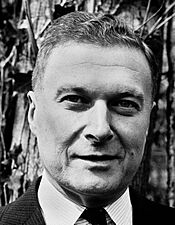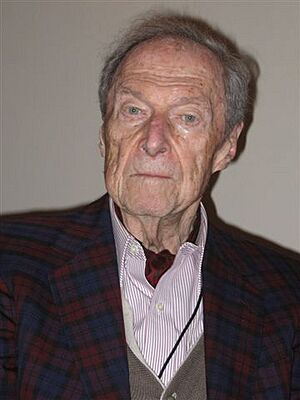Hilary Koprowski facts for kids
Quick facts for kids
Hilary Koprowski
|
|
|---|---|
 |
|
| Born | 5 December 1916 Warsaw, Government General of Warsaw
|
| Died | 11 April 2013 (aged 96) Wynnewood, Pennsylvania, U.S.
|
| Nationality | Polish |
| Citizenship | Poland, United States |
| Known for | Polio vaccine |
| Spouse(s) | Irena Koprowska (m. 1938) |
| Children | 2 |
| Awards | Albert B. Sabin Gold Medal (2007) |
| Scientific career | |
| Fields | Virology |
Hilary Koprowski (born December 5, 1916 – died April 11, 2013) was a Polish scientist who became famous in the United States. He was a virologist, meaning he studied viruses, and an immunologist, who studies how our bodies fight off diseases. He is best known for creating the world's first effective live polio vaccine.
Koprowski wrote or helped write over 875 scientific papers. He also helped edit several scientific journals. He received many awards and honors from different countries. These included the Belgian Order of the Lion and the French Legion of Honour.
For a time, some people wrongly suggested that the AIDS pandemic started from his polio vaccine. This idea was called the "oral polio vaccine AIDS hypothesis". However, scientists later found strong proof that the human immunodeficiency virus (HIV) appeared in humans before Koprowski's vaccine trials in Africa. This showed the accusation was false. A magazine called Rolling Stone later apologized to him.
Contents
Early Life and Education
Hilary Koprowski was born in Warsaw, Poland. His parents were educated and lived in Warsaw. His mother was a dentist. From a young age, Hilary showed talent in music. He took piano lessons at the Warsaw Conservatory starting at age twelve.
He earned a medical degree from Warsaw University in 1939. He also continued his music studies, getting degrees from the Warsaw Conservatory and the Santa Cecilia Conservatory in Rome. Even though he chose science as his main career, he never stopped playing music and even composed some pieces. In 1938, while still in medical school, Koprowski married Irena Grasberg, who was also a doctor.
Moving to a New Life
In 1939, Germany invaded Poland. Koprowski and his wife had to leave their home country. Hilary went to Rome to study piano, while Irena went to France. There, their first son, Claude, was born.
As World War II spread, Irena and their baby escaped from France. The Koprowski family reunited in Portugal and then moved to Brazil. In Rio de Janeiro, Koprowski worked for the Rockefeller Foundation. For several years, he researched how to find a vaccine against yellow fever.
After World War II, the Koprowskis moved to Pearl River, New York, in the United States. Hilary began working as a researcher for Lederle Laboratories. This is where he started his important work on the polio virus, which led to the first oral polio vaccine.
Later, Koprowski became the director of the Wistar Institute from 1957 to 1991. During his time there, the Wistar Institute became very well-known around the world for its vaccine research. It also became a special center for cancer research.
Hilary Koprowski passed away on April 11, 2013, at the age of 96. He died from pneumonia in Wynnewood, Pennsylvania. He and his wife are buried in Pennsylvania.
Hilary and Irena Koprowski had two sons. Their first son, Claude, was born in Paris in 1940 and later became a doctor. Their second son, Christopher, born in 1951, also became a doctor.
Developing the Polio Vaccine
While working at Lederle Laboratories, Koprowski created an early polio vaccine. His vaccine was given by mouth and used a weakened (or attenuated) polio virus. This meant the virus was made less harmful so it could not cause the disease but could still help the body build protection.
Koprowski believed a live, weakened virus vaccine was more effective. He thought it could enter the body's digestive system directly and provide protection for a lifetime. Another scientist, Jonas Salk, developed an injected polio vaccine using a killed virus. Salk's vaccine required booster shots, while Koprowski's oral vaccine was easier to give and less expensive because it didn't need injections.
Koprowski developed his vaccine by weakening the polio virus in the brain cells of a cotton rat. In January 1948, he tested the vaccine on himself. Then, on February 27, 1950, he gave it to 20 children at a home for disabled people in New York. Seventeen of the children developed antibodies to the polio virus, meaning their bodies learned to fight it. None of the children had any problems from the vaccine. Within ten years, Koprowski's vaccine was being used in many countries around the world.
It's interesting to know that Albert Sabin, another scientist who developed a well-known oral polio vaccine, used weakened polio virus that he had received from Koprowski for his own early research.
Work on Rabies Vaccine
Besides his important work on the polio vaccine, Koprowski also made big contributions to creating a better vaccine against rabies. Working with other scientists, Stanley Plotkin and Tadeusz Wiktor, he helped develop the HDCV rabies vaccine in the 1960s. This vaccine was approved for use in the United States in 1980.
Important Roles and Awards
Hilary Koprowski held many important positions during his career. He was the president of Biotechnology Foundation Laboratories, Inc., and led the Center for Neurovirology at Thomas Jefferson University. He received many grants for his research, including a record 50th grant from the National Institutes of Health.
He wrote or co-wrote over 875 scientific papers and helped edit several science journals. He also advised important health organizations like the World Health Organization (WHO) and the Pan American Health Organization.
Koprowski received many honorary degrees and national awards. These included the Order of the Lion from the King of Belgium and the French Order of Merit. He was also a member of important scientific groups like the National Academy of Sciences. In 2007, he was given the Albert Sabin Gold Medal for his work on vaccines.
In 2014, Drexel University created the Hilary Koprowski Prize in Neurovirology to honor his contributions to the study of viruses that affect the nervous system. This prize is given out every year.
Refuting the AIDS Accusation
A British journalist suggested that Koprowski's polio vaccine research in Africa in the late 1950s might have caused AIDS. This idea was called the OPV AIDS hypothesis.
However, the medical community has rejected this idea. Scientific evidence, including an article in the journal Nature, showed that the HIV-1 virus, which causes AIDS, appeared in Africa about 30 years before Koprowski's vaccine trials. The journal Science also stated that it was "almost completely certain" that the polio vaccine trials were not the cause of AIDS.
Koprowski himself denied the claim. He even won a lawsuit against Rolling Stone magazine, which had published similar false accusations. The magazine issued an apology.
See also
- Albert Sabin
- Discredited HIV/AIDS origins theories
- Jonas Salk
- List of Polish people
- Poles
- Polio vaccine
- Wistar Institute


